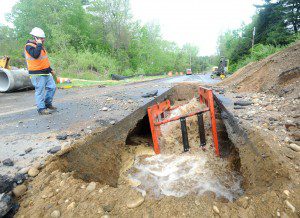
The city’s water commission has approved funds for the repair of a water main which was damaged during excavation required for a stormwater project on Lockhouse Road. (Photo by Carl E. Hartdegen)
WESTFIELD – The Water Commission voted last night to approve $17,503 for a construction project that was intended to replace a stormwater line on Arch Road, and that cost could balloon to more than $100,000 before the work is completed this summer.
City Engineer Mark Cressotti said that the money is needed to cover the cost of repair for an asbestos water main damaged during the stormwater project currently underway. The Board of Public Works issued the stormwater contract in March to a city firm, JL Raymaakers of 1100 East Mountain Road in Westfield, which submitted the low bid of $684,745 for the project. The project was designed to replace drainage lines and realign the road to reduce the present curve and straighten out the heavily traveled roadway.
The focus of the project is to correct the drainage problem created when the state and city revamped the Massachusetts Turnpike access, creating the jughandle system that motorists, northbound on North Elm Street (Clay Hill), now use to enter the Massachusetts Turnpike.
That project was designed with a large drainage pipe collecting stormwater from that area and dropping it into the existing Arch Road drainage system which terminates at Arm Brook just beyond the intersection of Arch and Lockhouse roads.
The problem with that drainage connection was soon apparent. Property and business owners observed stormwater, when collected in the jug handle during heavy downpours, began shooting up from the storm drain manholes, sometimes gushing a couple of feet high.
City officials and engineers investigated and discovered that the jug handle drainage was about twice the circumference of the Arch Road drainage line which could not accept the volume of stormwater being delivered by the jug handle line.
Cressotti said the road was marked for utilities as required by the state Safe Dig regulations, but that the water line location was not correctly marked. The Water Resource Department has a 12-inch water transmission line.
“In the process of constructing the new drainage line there have been several water (line) issues,” Cressotti said. “The lateral service line off the water main in front of the old Decorated Metals plant was leaking and had to be replaced.
“The water lines were marked out, but the contractor hit the lines because it was not where it had been marked,” Cressotti said. “As work proceeded the contractor hit the ‘mismarked’ water line and there was another washout. Then the water line blew again, but not in the project area.
Cressotti said the water line is asbestos concrete that becomes fragile over time when it is installed in wet soil. A similar problem in the Eastwood Acres subdivision cost the city over $1 million in unanticipated additional work during a sewer installation project. The original sewer contractor was fired, and has not been hired by the city since, and a new contractor was hired to replace the entire water line and complete the sewer project.
Cressotti said that in this case it was not the contractor’s fault that the water transmission line was damaged.
“It’s sometimes difficult to locate utilities from old plans,” Cressotti said.
Deputy Water Resource Superintendent Fran Cain said that it is also more difficult to accurately locate asbestos pipe than metal pipe.
Another problem with locating the pipe is that Lockhouse Road was relocated just beyond the intersection of Arch Road when a new bridge was constructed, so that part of the transmission line is near the outflow of the stormwater drainage system.
Cressotti submitted a change order to cover the contractor’s additional cost for the lateral service line work and estimated that the total cost of the repairs, replacing section of the asbestos line with ductile steel pipe, will be about $75,000.
Simply repairing damaged section may not be the Water Commission’s best option, Cressotti said. Once the stormwater work is complete, the road will be resurfaced. If the asbestos line continues to fail, it will become an effort of “chasing” that damage.
Cressotti suggested that a better, and more permanent, option would be to replace the asbestos line through the entire project site, which could push the additional work to over $100,000.
The commission requested Cressotti and Water Resource Superintendent Dave Billips to further study the board’s options and to determine if Raymaakers could do additional work as an emergency amendment under the existing contract or if the water line repair/replacement work would have to be bid as a separate contract.
“We’re into it for almost $100,000,” Billips said. “If we don’t replace it we’ll have a bigger problem down the road.”
Commission Chairman Ron Cole said the board “wants a very clear determination’ of its options.

